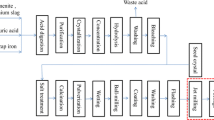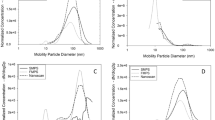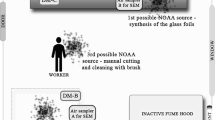Abstract
With the increased production and widespread use of nanomaterials, human and environmental exposure to nanomaterials is inevitably increasing. Therefore, this study monitored the possible nanoparticle exposure at a workplace that manufactures silver nanoparticles. To estimate the potential exposure of workers, personal sampling, area monitoring, and real-time monitoring were conducted over 3 days using a scanning mobility particle sizer and dust monitor at a workplace where the workers handle nanomaterials. The area sampling concentrations obtained from the injection room showed the highest concentration, ranging from 0.00501 to 0.28873 mg/m3. However, apart from the injection room, none of the area samplings obtained from other locations showed a concentration higher than 0.0013 mg/m3. Meanwhile, the personal sampling concentrations ranged from 0.00004 to 0.00243 mg/m3 over the 3 days of sampling, which was much lower than the silver TLV. The particle number concentrations at the silver nanoparticle manufacturing workplace were 911,170 (1st day), 1,631,230 (2nd day), and 1,265,024 (3rd day) particles/cm3 with a size range of 15–710.5 nm during the operation of the reactor, while the concentration decreased to 877,364.9 (1st day), 492,732 (2nd day), and 344,343 (3rd day) particles/cm3 when the reactor was stopped.




Similar content being viewed by others
References
Aitken RJ, Creely KS, Tran CL (2004) Nanoparticles: an occupational hygiene review. Suffolk, UK: Health & Safety Executive
Brouwer D, Berges M, Virji MA, Fransman W, Bello D, Hodson L, Gabriel S, Tielemans E (2012) Harmonization of measurement strategies for exposure to manufactured nano-objects; report of a workshop. Ann Occup Hyg 56(1):1–9
BSI PD 6699-3 (2010) Nanotechnologies—Part 3: guide to assessing airborne exposure in occupational settings relevant to nanomaterials. BSI, London
Curwin B, Bertke S (2011) Exposure characterization of metal oxide nanoparticles in the workplace. J Occup Environ Hyg 8:580–587
Dahm MM, Evans DE, Schubauer-Berigan MK, Birch ME, Fernback JE (2012) Occupational exposure assessment in carbon nanotube and nanofiber primary and secondary manufacturers. Ann Occup Hyg 56:542–556
Han JH, Lee EJ, Lee JH, So KP, Lee YH, Bae GN, Lee SB, Ji JH, Cho MH, Yu IJ (2008) Monitoring multiwalled carbon nanotube exposure in carbon nanotube research facility. Inhal Toxicol 20:741–749
ISO TR 12885 (2008) Nanotechnology—health and safety practices in occupational settings relevant to nanotechnologies. ISO, Geneva
ISO 15900 (2009) Determination of particle size distribution—differential electrical mobility analysis for aerosol particles. ISO, Geneva
Kuhlbusch TAJ, Asbach C, Fissan H, Gohler D, Stintz M (2011) Nanoparticle exposure at nanotechnology workplaces: a review. Part Fibre Toxicol 8:22
Lee JH, Lee SB, Bae GN, Jeon KS, Yoon JU, Ji JH, Sung JH, Lee BG, Lee JH, Yang JS, Kim HY, Kang CS, Yu IJ (2010) Exposure assessment of carbon nanotube manufacturing workplaces. Inhal Toxicol 22:369–381
Lee JH, Kwon M, Ji JH, Ahn KH, Han JH, Yu IJ (2011) Exposure assessment of workplaces manufacturing nanosized TiO2 and silver. Inhal Toxicol 23(4):226–236
Lee JH, Mun J, Park JD, Yu IJ (2012) A health surveillance case study on workers who manufacture silver nanomaterials. Nanotoxicology 6:667–669
NIOSH (1999) NIOSH manual of analytical methods. Methods 7402. NIOSH, Cincinnati, OH
NIOSH (National Institute for Occupational Safety and Health) Manual of Analytical Methods (NMAM) (2003) Forth edition, Elements by ICP 7300 (Nitric/Perchloric Acid Ashing). NIOSH, Cincinnati
OECD (2009) Emission assessment for identification of sources and release of airborne manufactured nanomaterials in the workplace: compilation of existing guidance, Series on the safety of manufactured nanomaterials No. 11, OECD, Paris
Peters TM, Heitbrink WA, Evans DE, Slavin TJ, Maynard AD (2006) The mapping of fine and ultrafine particle concentration in an engine machining and assembly facility. Ann Occup Hyg 50:249–257
Ramachandran G, Ostraat M, Evans DE, Methner MM, O’Shaughnessy P, D’Arcy J, Geraci CL, Stevenson E, Maynard A, Richabaugh K (2011) A strategy for assessing workplace exposure to nanomaterials. J Occup Environ Hyg 8:673–685
Acknowledgments
This research was supported by the Nano R&D program through the National Research Foundation of Korea funded by the Korean Ministry of Education, Science and Technology (2011-0019171).
Author information
Authors and Affiliations
Corresponding author
Rights and permissions
About this article
Cite this article
Lee, J.H., Ahn, K., Kim, S.M. et al. Continuous 3-day exposure assessment of workplace manufacturing silver nanoparticles. J Nanopart Res 14, 1134 (2012). https://doi.org/10.1007/s11051-012-1134-8
Received:
Accepted:
Published:
DOI: https://doi.org/10.1007/s11051-012-1134-8




